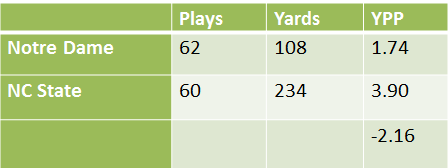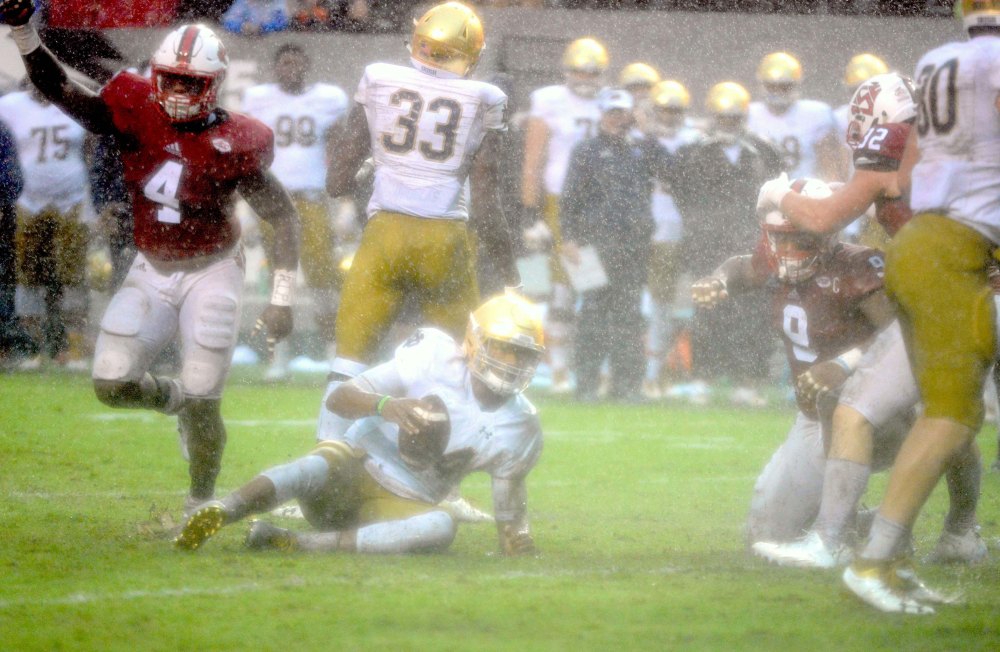Storm clouds keep gathering over the Notre Dame football program after a 10-3 loss at NC State. Taking a look at run/pass splits and success rates, and how the Irish missed opportunities to capitalize on field position advantages.
Confused? Check out the advanced-stats glossary here.
Explosiveness

Let’s get this out of the way first – this game was less football, more greased watermelon. It’s stupid that the game was played (at least on that date/time), it was insane to watch, but at least it equally stupid conditions for both teams to have to play through.
One ridiculous consequence moving forward – this game actually did wonders for Notre Dame’s advanced stats! As much important context as these numbers provide, I don’t think there’s a coefficient or opponent adjustment that accounts for hurricane-like conditions.
So as a result, Notre Dame’s defensive S&P+ rating jumped 48 spots! Strictly by the numbers, it appears like the defense held what’s been a strong NC State offense to 3.9 YPP and three points. All of that is true, yet it probably isn’t representative of the actual quality of the performance. So I’m not sure what to do with that except know moving forward that it’s probably inflating the defense’s (and deflating the offense’s) statistics a fair bit, although the impact will diminish as more and more games are played.

Criticizing play-calling is cheap, easy, and often unfair. But in this case, the strategic response to conditions that made passing nearly impossible seemed obvious. Explosive plays weren’t going to happen – the longest passing completion in this game was 13 yards on NC State’s first drive. There were 18 third down attempts of 3rd and 5 or more, and that pass on 3rd and 12 was the only first-down conversion.
Efficiency was going to rule the day, and the only way to be consistently efficient was going to be running the ball to create manageable 3rd downs. That did not happen for Notre Dame – the Irish passed on 12 of 23 first downs in this game, compared to just 4 out of 25 for NC State.
How did that work? Well on average, the Irish faced 9.9 yards to go on 2nd down, and then 10.5 yards to go on 3rd down! I couldn’t force myself to go back and watch again, but even just checking the last drive, there were at least three pass calls that appear as runs because of Kizer scrambles. So we’re in essence looking at a pass-first strategy (at least 53%) in the middle of Hurricane Matthew.
Early on, I can understand Kelly giving the passing game a shot. Wolfpack QB Ryan Finley completed that 13-yard out on 3rd down, and while it wasn’t a great throw, maybe that gives you the idea passing won’t be as bad as it looks. DeShone Kizer passed for over 300 yards at Clemson in a tropical storm last year!
And Kizer started the game 5-of-6 for 27 yards, which all things considered, was pretty encouraging. But then it quickly became apparent that the strategy was completely unsustainable, and then nonsensical. A big QB who is one of the best in college football could not throw an accurate ball downfield. The Notre Dame passing offense was a drunk playing darts that hit a couple bull’s-eyes early, then could barely stand up but kept insisting on going double or nothing.
Efficiency

There’s no guarantees that running the ball would have changed the complexion of the game, but taking out the fumbled snaps and sacks counted as negative rushing yardage, the Irish ran for 3.0 yards/carry. Putting the five sacks where they belong, as pass plays, nets 0.9 yards/passing attempt.
The lack of confidence, commitment, and creativity in the run game was as disturbing as the run/pass decision-making. Late in the game a few more daring run plays were drawn up – a speed option, counter draw, and Zaire’s one-play QB draw. But generally it seems like it would have been beneficial to attempt some of the efforts that NC State utilized earlier – designed QB runs with 10 blockers (whether with Kizer or Zaire), jet sweeps or fakes of the jet sweep, or the pop or shovel passes that are low risk (incompletions instead of fumbles if the ballcarrier can’t secure) but function like runs. There were zero rushing attempts by non-running backs and quarterbacks in the game by Notre Dame.

Defensively, it’s hard to know what to make of this one, but it’s hard to argue with only three points given up. Seeing the first few forced fumbles of the year was pleasant, but it’ll be even more rewarding to see them take place when the ball isn’t the texture of a water balloon.
Still, the defensive line showed some nice flashes of life against an offensive line that’s been very solid to date. Jerry Tillery in particular had a very nice game, and watching Daniel Cage swallow a running back on a screen pass filled me with great joy. There seemed to be some improved aggression as the game went on and it became clear that the Wolfpack couldn’t threaten anyone with passes downfield.
It was a little disheartening to see the old “running QB” substitution to continue to be very effective against this Irish defense, as backup Jalen McClendon tallied 56 yards on 10 carries. But for now, we’ll take what we can get, and some encouraging signs from the defensive line certainly qualify.
Field Position
Average Starting Field Position
Notre Dame – Irish 41
NC State– Wolfpack 29
Notre Dame won the field position battle in this one, the blocked punt for a touchdown being the unfortunate exception if you want to lump special teams in this category. Despite being significantly outgained, the game was well within reach for the Irish if they could have converted scoring opportunities they received from turnovers and special teams struggles from NC State. Tyler Newsome’s 69-yard punt was nice, and Justin Yoon’s field goal in the storm was magnificent.
Finishing Scoring Drives

Here’s where the Irish blew their opportunities – with drives starting at the Wolfpack 22, 25, and 22 again, the Irish could only net 3 points. The first of those drives included a 1st and goal from the 6, and then the offense promptly went in reverse – false start, sack, incomplete pass, interception.
The drive where Yoon converted Notre Dame’s only points of the game featured 1st and 2nd down runs, then a 3rd down sack that made his attempt more difficult. The final opportunity included yet another sack, and then three straight incompletions as Kelly opted against kicking another field goal from a similar distance.
Turnovers
The Irish turned it over three times – one ill-advised throw leading to an interception, and two fumbles. The Wolfpack also lost two fumbles, and essentially gave Notre Dame a third turnover when their punter was forced to take a knee on a bad snap. Unfortunately these three “turnovers”, which had given the Irish offense tremendous field position, could not be converted into more points.
This sucks
There’s not much more to say than that. It was a stupid game, and a not totally unexpected loss, yet the way it unfolded was frustrating and mind-numbing at times. In the grand scheme of things, will it really make a big difference in a season that ends up somewhere between 4-8 and 6-6? (Yes, 3-9 is a real possibility, but I refuse to acknowledge it really appears to be in play – S&P+ gives it only a 3% chance).
It just dials up the frustration with the coaching staff and team performance, and the hot takes about hot seats and what won-loss record is unacceptable or grounds for instant termination. It is not any fun to lose, or be filled with rage at coaches (who are themselves criticized for looking like they are filled with rage on the sidelines), or start playing the coaching carousel “what if” game six weeks into the season.
Worth mentioning is that there doesn’t appear to be a plethora of great head coaching candidates on the market. There’s also the very real possibly Notre Dame would be the 4th most appealing open job this winter behind LSU, Texas, and USC.
This is a season that in many ways now has the nauseating feel of late Weis years – I wouldn’t be surprised if this offseason resembles 2008-2009, when a huge vocal portion of the alumni and fan base had written Weis off and wanted anyone else in place, just get rid of him as soon as possible. It can become poisonous for the atmosphere around the program, with uncertainty affecting recruiting (where you already have enough challenges), development, and leadership.
Yet Kelly has a much more proven resume both before and in South Bend than Weis, and leading indicators trend much more positively, even if they’ve suffered similar losses to less talented opponents. I’m not sure how this ends, and I don’t see it ending any time soon, but I just hope this interim period between what will have to be a dramatic turnaround or continued failure resulting in a coaching change is as painless as possible. Beat Stanford.





God bless you, Michael, for putting this piece together.
I would have just requested that we pretend this game didn’t even happen and try to forget about it. You’re a braver man than I am for putting yourself on the Wheel of Pain and completing this task.
Go Irish! BEAT STANFORD!!